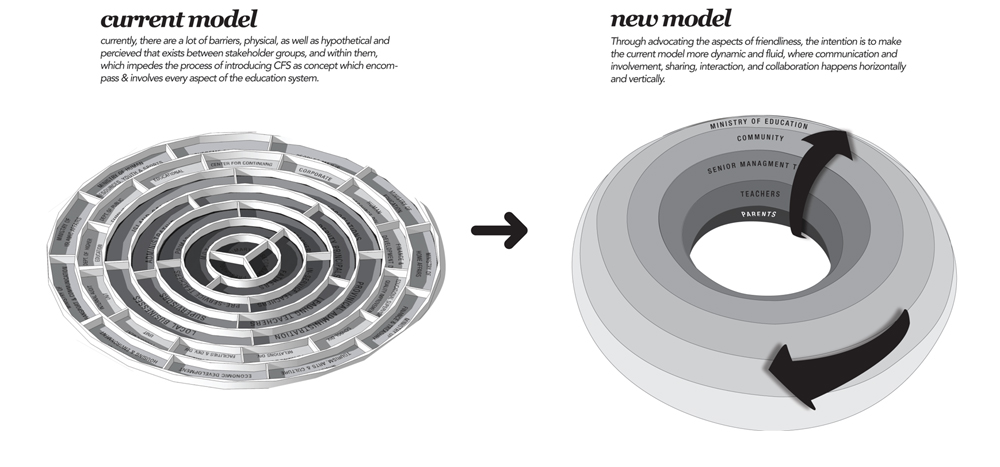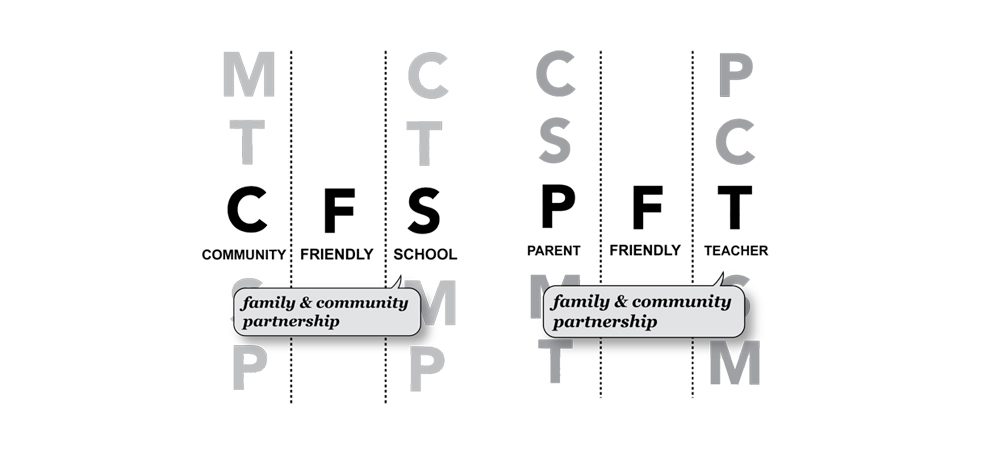CFBS Advocacy Campaign (Part 1) Research & Master Planning
CFS ( CHILD FRIENDLY SCHOOL)
Introduction
Schools evolve retaining what is good and adding innovations preparing the world for the future. They take shapes of ideas prevalent in their locations and times. Industrialization is considered to have dictated the basis for the current most commonly seen regimented school system; modelled after a cost efficient, market oriented industry consisting of different components such as factories, laboratories and various offices.
In the recent decades children of Maldives were also streamed into an education system persistently campaigning to enroll all. Being a least developed country, a lot of financing for this expansion was raised by international agencies such as UNICEF. This has made it possible for 93,433 students (approximately 96% of the population between 3 and 18 years old) enrolled in schools in 20081, making approximately 100% enrollment at age 6 and 80% at age 16 and 40% at age 18. The only widely accepted mechanism to evaluate the performance of students now are LONDON GCE O/L results, which shows that 24.3% of the students who sat the exams in 2008 failed (below ‘C’ grade) in all subjects including 11,952 ‘U’ grades for papers costing more than 9 million Rufiya2. Labelled as failures, chances of further development become narrower making the system fail to cater to the “industry”. According to the Minister of Education, Dr. Mustafa Lutfi the cost imposed on the government due to lack of quality education can best be described by the cost of imprisoning juveniles; currently approximately 15 times more money is spent for each imprisoned juvenile than for each student every month.
Child Friendly Schools stem from a belief that the challenge in education is not simply to get children into a school, but also to improve the overall quality of schooling. According to UNICEF’s CFS Manual, the purpose of a CFS model is to move schools and education systems progressively towards quality standards, addressing all elements that influence well-being and rights of the child as a learner and the main beneficiary of teaching, while improving other school functions in the process3. This paradigm shift changes schools to be more child centric making children active learners, taking a holistic approach for improving all dimensions, hence enabling the child to develop and grow in multiple dimensions.
CFS was originally introduced to Maldives by the Ministry of Education with support from UNICEF for 22 least developed school projects in 2002. After the 2004 Tsunami, Build Back Better initiative allowed 64 more CFS project schools to be built. Like many agencies, decades ago UNICEF’s assistance involved mainly interventions related to pedagogic factors such as teacher training, supply of text books and learning materials, advocacy for policies on class size and teaching methodology. This ‘single-factor’ approach to school quality produced improvements, but they were frequently compromised by other factors in education settings. UNICEF’s shift from a single-factor approach to a package approach in promoting education quality has been a significant phase in the evolution of CFS models. Another important phase has been the shift from targeted to system-wide interventions in education. Narrowly focused interventions (typically designed as projects) continue to be necessary in some circumstances, but they are not the most efficient way to providing quality basic education for all children.
The government’s Strategic Action Plan 2008 – 2013 indicates that in principle CFS model aligns with the education policies and actions4. This years’ (2010) allocated government budget for education is RF 2,066,500,000 (17.1%) of the total budget5. Currently there are 225 schools in the Maldives (208 offering primary, 188 offering secondary, 38 offering higher secondary education) with 7,534 teachers (including 1,789 untrained teachers and 2,560 expats) in 2008.
The research by Mooinc Pvt. Ltd. undertaken for UNICEF to understand the current situation of CFS in the Maldives for the purpose of developing a strategic plan for advocating CFS nationally. With the intention of understanding the status of CFS among each of the stakeholders, determining prerequisites and sequencing the messages to develop a sustainable and coherent overall strategy.
Research Stage for Master Planning
Based on initial background study and discussions with UNICEF a qualitative analysis of the views of different stakeholders identified were conducted using focus group interviews & school observations. All interviews consisted of enquiries about strengths and weaknesses of existing situations of the schools, and what CFS meant for each of the groups.
The major concerns in regard to CFS in the Maldives, highlighted from this research is the lack of coherency and consistency in the current implementation. CFS is defined especially at school level, in terms of prescribed physical and organizational features & characteristics, as well as within the confine of a single CFS dimension. The findings also highlighted the need to involve and gain support of CFS, inter-sectoral wise at national policy level, to enable sustainable implementation towards a more holistic strategic goal of providing quality of life for all children.
It is highly recommended to initiate advocation of the broader context, thinking and attitudes in relation to CFS. This means breaking down the three components, “the Child”, “Friendliness”, and “School”, that make up CFS, and advocate them within a consistent and coherent communication plan.
Correspondence between advocacy components and communication mediums.
The advocacy should create the right situation that encourage participation and involvement by local stakeholders in collaboration with policy level, in support of the child rights, opinion and voice, to provide continual feedback and revisions to the qualities that define CFS for their particular community, so that it has relevance to their needs and requirements. This would enable the establishment of ownership and empowerment at community level, as well
as propagate the idea that CFS qualities are not absolute or “set in stone” but flexible & continually adaptable.
Campaign Strategy Development.
Figure 1: Shows the limited perception and scope of CFS in the Maldives currently
As the above figure shows, within the scope of CFS, dominate perception remains limited to two components, one being “effective teaching and learning” advocated and currently implemented widely amongst majority of schools, and secondly, the physical change brought upon by the tsunami, “Build Back Better” campaign, as an initiative to introduce child friendly class rooms across all disaster effected schools. Both of these factors are very tangible and visual changes, but the manner it has been implemented has meant, that the core attitudinal aspect of CFS, “Friendliness”, which determines and binds together, all the 5 dimensions of CFS, has not been clearly and substantially integrated or linked to these changes. Hence, every action or program conducted under the name of CFS seems independent and unrelated, causing confusion amongst the stakeholders. The program wise implementation of these particular aspects of CFS has also meant that only limited groups within the education system, national ministerial level and public are fully involved or aware of CFS in any way or form. This has created misinterpretation of good intentions between stakeholders at every level within the scope of current CFS implementation, impeding and slowing down the process of introducing CFS nationwide.
The main recommendation derived from the research findings, hence was to advocate the core attitudinal aspect of the CFS concept, i.e. friendliness, which binds the 5 dimensions together, as a cohesive whole, to enable programs conducted under the name to have meaning and relevance to all stakeholders involved for the concept to be implemented in a sustained and effective manner.
Figure 2: Shows the that Friendliness aspect of “CFS”, is the core differentiating factor and unique selling proposition which needs to be advocated.
Friendliness as a concept is broad, but within the context of “CFS”, it is predominately about sharing, involving, interacting, and collaborating. The intention is to advocate these core concepts of “Friendliness”, to break down the communication barriers that exists or more often, perceived to exist, within stakeholder groups, as well as between groups. This would enable more proactive involvement and motivation for all stakeholder groups to participate in
the implementation of CFS, in a broad and holistic manner.
As shown in figure 3 below the idea is to create a more fluid model of communication, horizontally and vertically, by developing situations for sharing, interacting and collaborating, between and within stakeholder groups, in a sustainable method or process.
 Figure 3: Shows the transformation of the stakeholders’ involvement from a restricted model to a more fluid and dynamic model of interaction, sharing and collaboration.
Figure 3: Shows the transformation of the stakeholders’ involvement from a restricted model to a more fluid and dynamic model of interaction, sharing and collaboration.
The Diagram below shows horizontal and vertical communication between stakeholders will enable each of the 5 dimensions of CFS to be identified, and achieved.
 Figure 4: Shows the different configuration allowed through the fluidity of the new model, allowing 5 dimensions of CFS to be achieved.
Figure 4: Shows the different configuration allowed through the fluidity of the new model, allowing 5 dimensions of CFS to be achieved.
In developing a the communication plan the main strategy was to develop the right situations that allow the core concepts of “friendliness” to be incorporated as method that is participatory and inclusive of all stakeholders, individually and as a whole, in an effort to advocate wider understanding & positive acceptance of the different dimensions of CFS, locally & nationally.
CFBS Advocacy Campaign (Part 2) Communication Identity
CFBS Advocacy Campaign (Part 3) Communication Strategy




